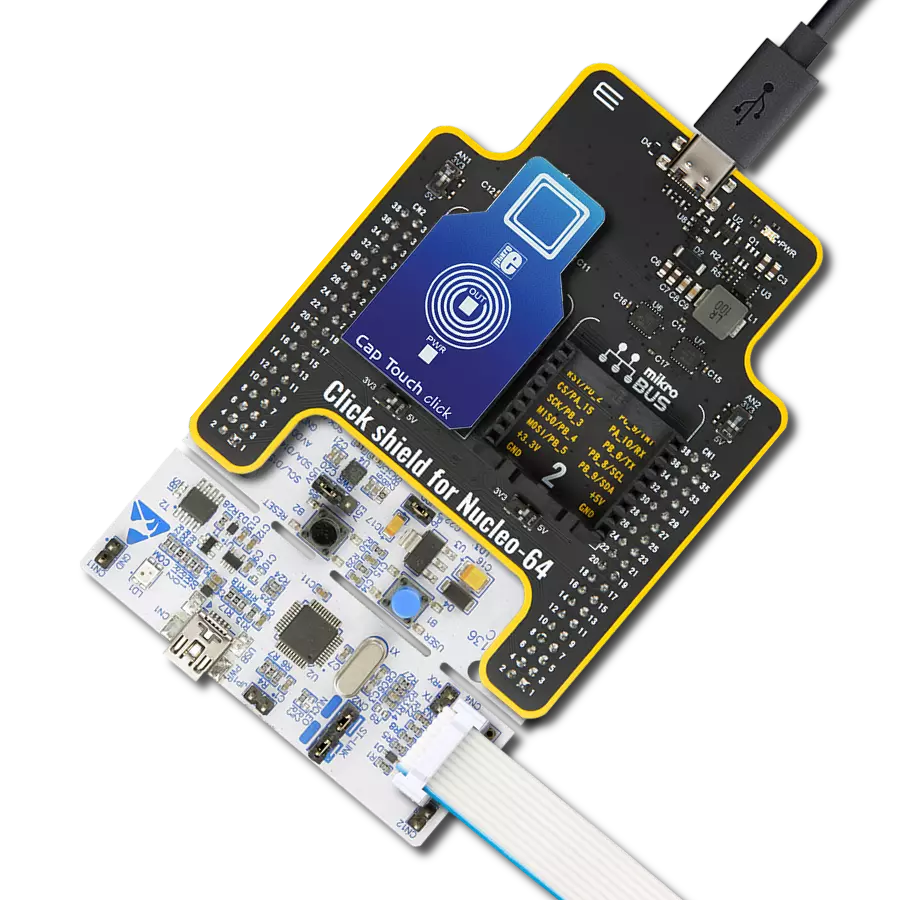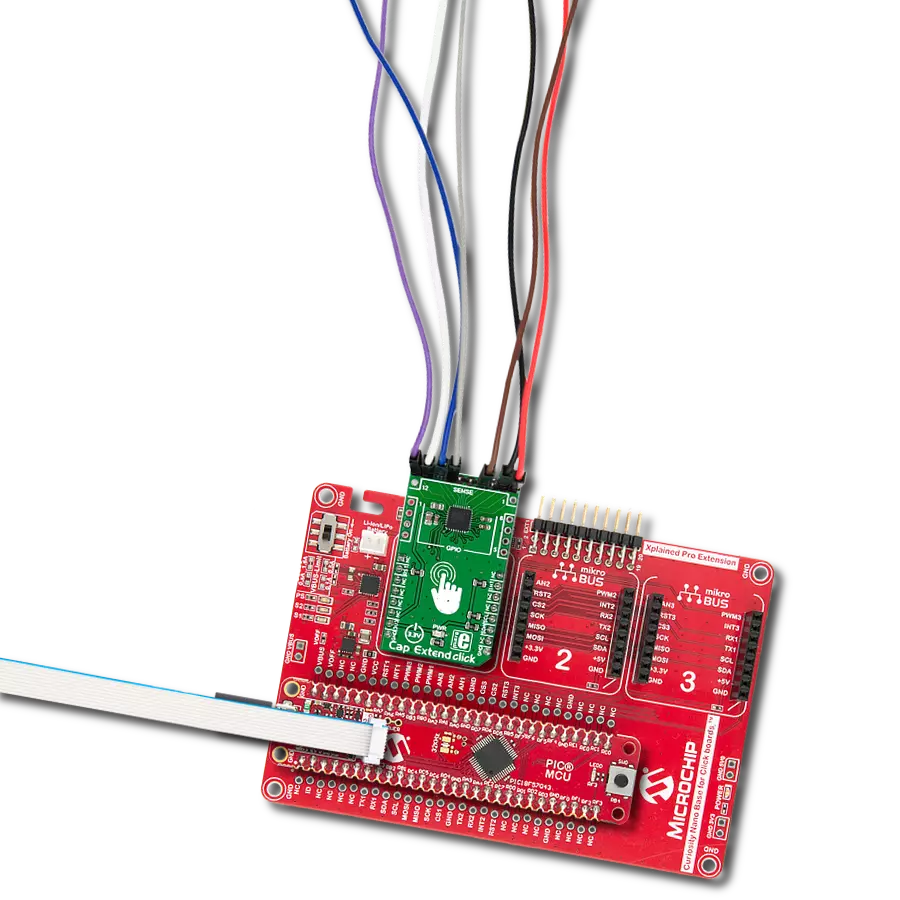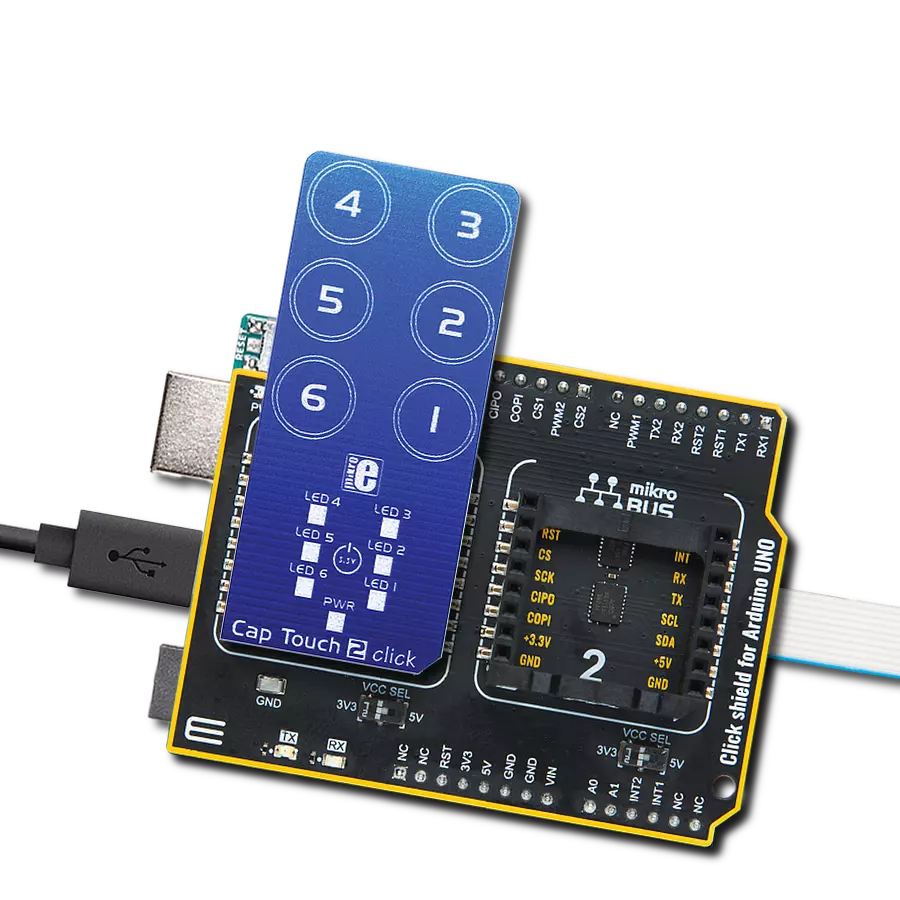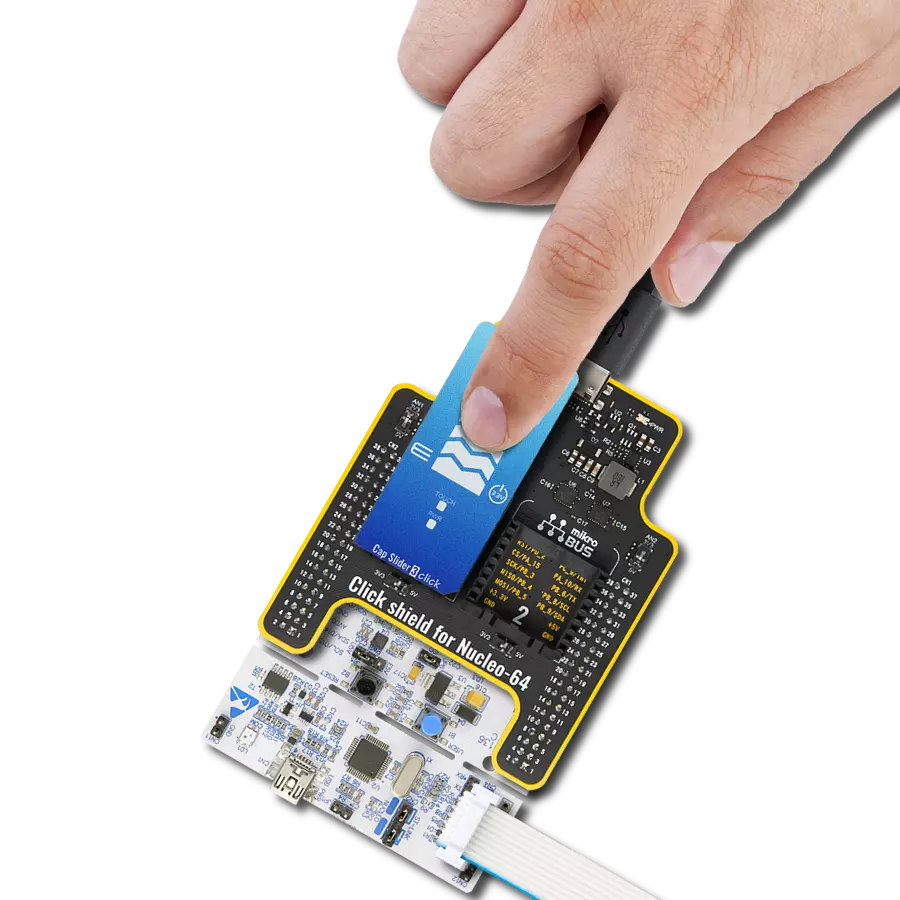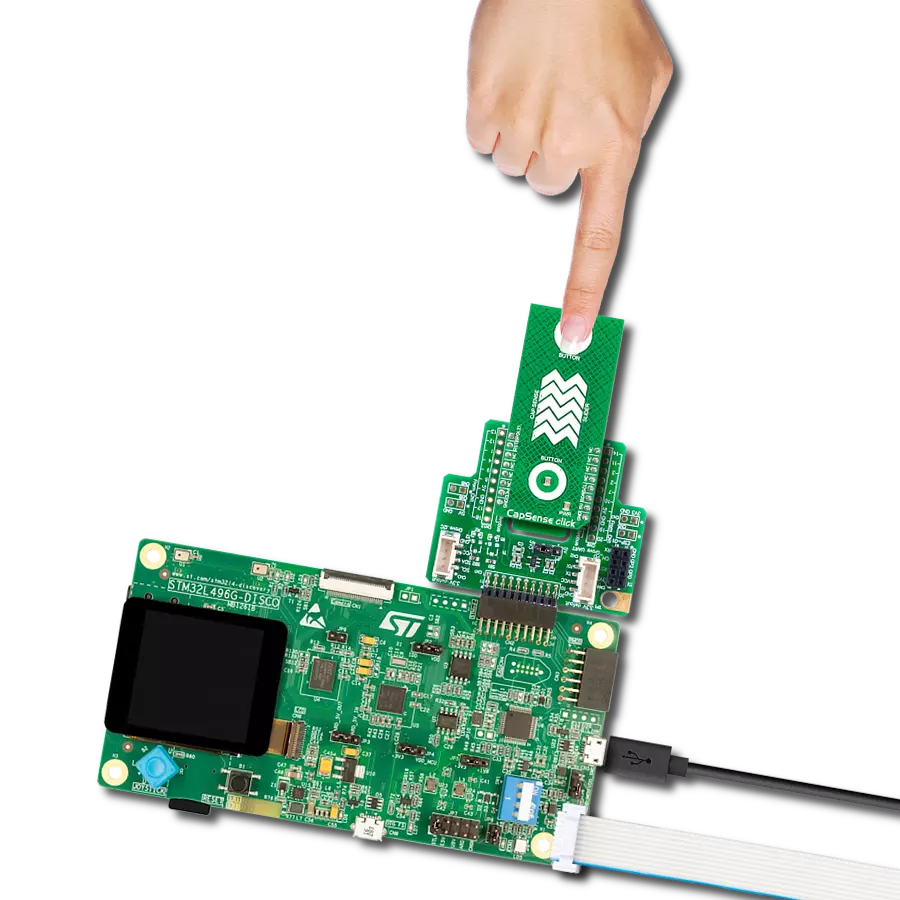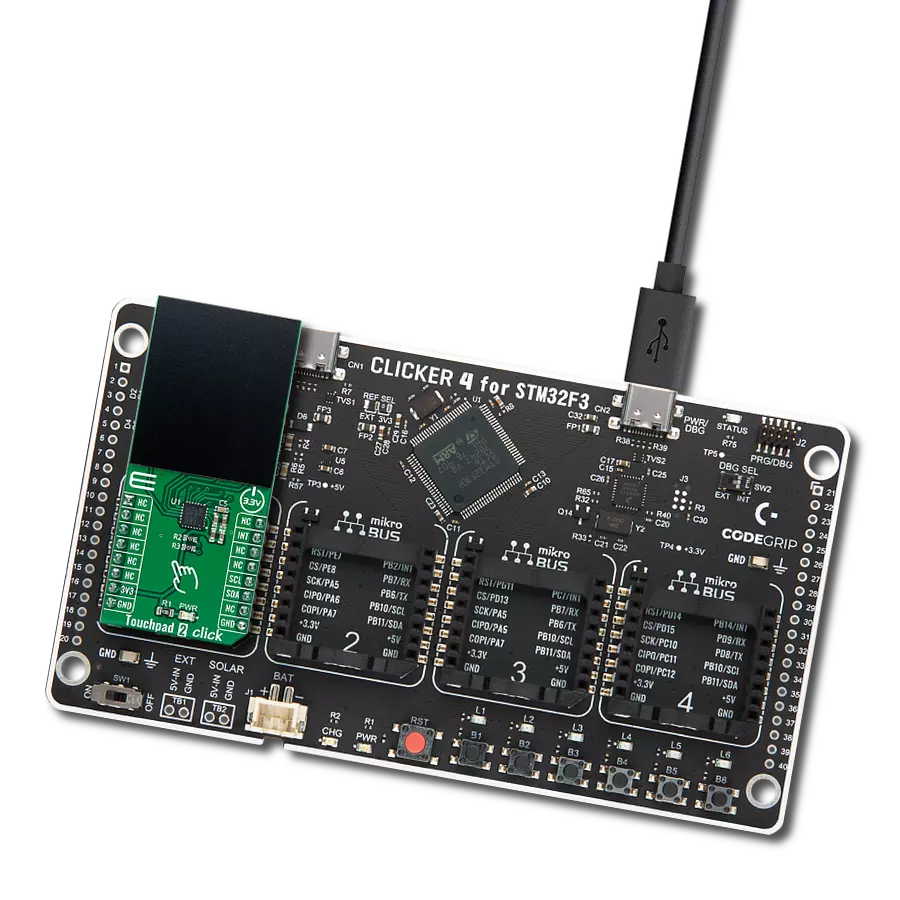Navigate, scroll, and zoom effortlessly with intuitive finger movements
A
A
Hardware Overview
How does it work?
Touchpad 3 Click is based on the MTCH6301, a turnkey capacitive touch controller that allows users to quickly and easily integrate projected capacitive touch into their applications from Microchip. The MTCH6301 is characterized by a multitouch function that allows up to 10 pad touches, gesture detection, reporting, single and dual touch drawing, self or mutual signal acquisition, and built-in noise detection and filtering. Single-finger gestures are a fast and intuitive way to navigate a feature-rich human-machine interface. It supports 11 single-finger gestures natively without requiring interaction from the master processor. On the front side of the Touchpad 3 Click, there is a clearly defined field that represents a touchpad area. This area is a matrix of conductive electrodes on the PCB, electrically isolated from each other, arranged as rows and columns of X and Y. An electrode
consists of multiple diamond-shaped elements, each connected to the next with a conductive neck. Touchpad 3 Click communicates with MCU using the standard I2C 2-Wire interface that can operate at a maximum speed of 400kbps. The MTCH6301 I2C protocol follows a serial streaming format, not a register-based protocol. For accomplished I2C protocol, the device will assert the active-high INT pin, which is held low during all other activities whenever a new packet of data is ready to be transmitted to the host. This event can happen under two conditions: when a command has been sent to the controller, when the new touch or gesture data is available, or when the response to this command is ready. As mentioned before, the INT pin routed on the INT pin of the mikroBUS™ socket is utilized by MTCH6301 to signal when the data is available and that the master controller should invoke a master
read. Alongside this feature, this Click board™ also has a Reset function routed on the RST pin of the mikroBUS™ socket that will reset the MTCH6301 by driving the RST pin low. When released, the device will assert the INT pin until it has finished initialization routines. For ease of use, the MTCH6301 has the recommended Start-Up sequence that can also be found in the example code that MIKROE offers to its users. This Click board™ is designed to be operated only with a 3.3V logic voltage level. A proper logic voltage level conversion should be performed before the Click board™ is used with MCUs with different logic levels. However, the Click board™ comes equipped with a library that contains easy-to-use functions and an example code that can be used as a reference for further development.
Features overview
Development board
Nucleo-64 with STM32F091RC MCU offers a cost-effective and adaptable platform for developers to explore new ideas and prototype their designs. This board harnesses the versatility of the STM32 microcontroller, enabling users to select the optimal balance of performance and power consumption for their projects. It accommodates the STM32 microcontroller in the LQFP64 package and includes essential components such as a user LED, which doubles as an ARDUINO® signal, alongside user and reset push-buttons, and a 32.768kHz crystal oscillator for precise timing operations. Designed with expansion and flexibility in mind, the Nucleo-64 board features an ARDUINO® Uno V3 expansion connector and ST morpho extension pin
headers, granting complete access to the STM32's I/Os for comprehensive project integration. Power supply options are adaptable, supporting ST-LINK USB VBUS or external power sources, ensuring adaptability in various development environments. The board also has an on-board ST-LINK debugger/programmer with USB re-enumeration capability, simplifying the programming and debugging process. Moreover, the board is designed to simplify advanced development with its external SMPS for efficient Vcore logic supply, support for USB Device full speed or USB SNK/UFP full speed, and built-in cryptographic features, enhancing both the power efficiency and security of projects. Additional connectivity is
provided through dedicated connectors for external SMPS experimentation, a USB connector for the ST-LINK, and a MIPI® debug connector, expanding the possibilities for hardware interfacing and experimentation. Developers will find extensive support through comprehensive free software libraries and examples, courtesy of the STM32Cube MCU Package. This, combined with compatibility with a wide array of Integrated Development Environments (IDEs), including IAR Embedded Workbench®, MDK-ARM, and STM32CubeIDE, ensures a smooth and efficient development experience, allowing users to fully leverage the capabilities of the Nucleo-64 board in their projects.
Microcontroller Overview
MCU Card / MCU
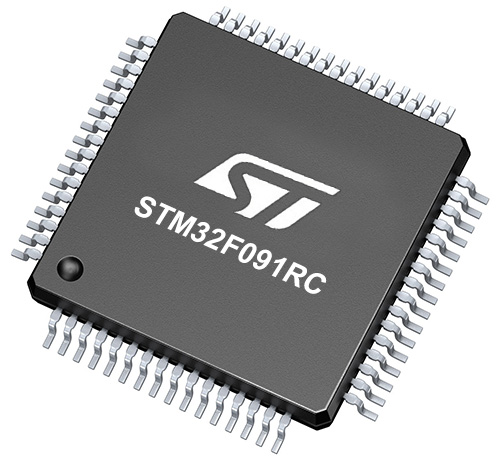
Architecture
ARM Cortex-M0
MCU Memory (KB)
256
Silicon Vendor
STMicroelectronics
Pin count
64
RAM (Bytes)
32768
You complete me!
Accessories
Click Shield for Nucleo-64 comes equipped with two proprietary mikroBUS™ sockets, allowing all the Click board™ devices to be interfaced with the STM32 Nucleo-64 board with no effort. This way, Mikroe allows its users to add any functionality from our ever-growing range of Click boards™, such as WiFi, GSM, GPS, Bluetooth, ZigBee, environmental sensors, LEDs, speech recognition, motor control, movement sensors, and many more. More than 1537 Click boards™, which can be stacked and integrated, are at your disposal. The STM32 Nucleo-64 boards are based on the microcontrollers in 64-pin packages, a 32-bit MCU with an ARM Cortex M4 processor operating at 84MHz, 512Kb Flash, and 96KB SRAM, divided into two regions where the top section represents the ST-Link/V2 debugger and programmer while the bottom section of the board is an actual development board. These boards are controlled and powered conveniently through a USB connection to program and efficiently debug the Nucleo-64 board out of the box, with an additional USB cable connected to the USB mini port on the board. Most of the STM32 microcontroller pins are brought to the IO pins on the left and right edge of the board, which are then connected to two existing mikroBUS™ sockets. This Click Shield also has several switches that perform functions such as selecting the logic levels of analog signals on mikroBUS™ sockets and selecting logic voltage levels of the mikroBUS™ sockets themselves. Besides, the user is offered the possibility of using any Click board™ with the help of existing bidirectional level-shifting voltage translators, regardless of whether the Click board™ operates at a 3.3V or 5V logic voltage level. Once you connect the STM32 Nucleo-64 board with our Click Shield for Nucleo-64, you can access hundreds of Click boards™, working with 3.3V or 5V logic voltage levels.
Used MCU Pins
mikroBUS™ mapper
Take a closer look
Click board™ Schematic

Step by step
Project assembly
Track your results in real time
Application Output
1. Application Output - In Debug mode, the 'Application Output' window enables real-time data monitoring, offering direct insight into execution results. Ensure proper data display by configuring the environment correctly using the provided tutorial.

2. UART Terminal - Use the UART Terminal to monitor data transmission via a USB to UART converter, allowing direct communication between the Click board™ and your development system. Configure the baud rate and other serial settings according to your project's requirements to ensure proper functionality. For step-by-step setup instructions, refer to the provided tutorial.

3. Plot Output - The Plot feature offers a powerful way to visualize real-time sensor data, enabling trend analysis, debugging, and comparison of multiple data points. To set it up correctly, follow the provided tutorial, which includes a step-by-step example of using the Plot feature to display Click board™ readings. To use the Plot feature in your code, use the function: plot(*insert_graph_name*, variable_name);. This is a general format, and it is up to the user to replace 'insert_graph_name' with the actual graph name and 'variable_name' with the parameter to be displayed.

Software Support
Library Description
This library contains API for Touchpad 3 Click driver.
Key functions:
touchpad3_general_configuration- The function performs the general configuration of the MTCH6301touchpad3_decoding_configuration- The function performs the decoding configuration of the MTCH6301touchpad3_sensor_mapping_configuration- The function configures the sensor mapping of the MTCH6301
Open Source
Code example
The complete application code and a ready-to-use project are available through the NECTO Studio Package Manager for direct installation in the NECTO Studio. The application code can also be found on the MIKROE GitHub account.
/*!
* @file main.c
* @brief Touchpad3 Click example
*
* # Description
* This example prints the coordinate points of the position we touch on a Click. We use RST and INT
* pins. The whole project is done through i2c communication.
*
* The demo application is composed of two sections :
*
* ## Application Init
* Initialization driver enables - Initializes I2C, set RST pin as an output, set INT pin as input and start to write log.
* I2C, perform a hardware reset, configuration (general, decoding, sensor mapping), get device ID and enable the touch, also write log.
*
* ## Application Task
* This is an example that demonstrates the use of the TouchPad 3 Click board. TouchPad 3 Click board uses USB UART log to display
* X and Y coordinates of the touch, depending on the selected Touch ID.
*
* @author Jelena Milosavljevic
*
*/
#include "board.h"
#include "log.h"
#include "touchpad3.h"
static touchpad3_t touchpad3;
static log_t logger;
uint8_t touch_id_state;
uint8_t status_data;
uint16_t x_axis;
uint16_t y_axis;
uint32_t device_id;
touch_data_t touch_data;
void display_status ( void ) {
switch ( status_data ) {
case ( TOUCHPAD3_CMD_STATUS_SUCCESS ) : {
log_printf( &logger, " Command execution successful " );
Delay_ms ( 10 );
break;
}
case ( TOUCHPAD3_CMD_STATUS_PARAM_OUT_OF_RANGE ) : {
log_printf( &logger, " Parameter out of range " );
Delay_ms ( 10 );
break;
}
case TOUCHPAD3_CMD_STATUS_TIMEOUT: {
log_printf( &logger," Timeout : " );
log_printf( &logger, " not enough bytes received " );
Delay_ms ( 10 );
break;
}
case TOUCHPAD3_CMD_STATUS_UNRECOGNIZED: {
log_printf( &logger, " Unrecognized command ");
Delay_ms ( 10 );
break;
}
case TOUCHPAD3_CMD_STATUS_INVALID_PARAM: {
log_printf( &logger, " Invalid parameter " );
Delay_ms ( 10 );
break;
}
case TOUCHPAD3_CMD_STATUS_MISSING_OR_EXTRA_PARAM: {
log_printf( &logger, " Missing or extra parameter " );
Delay_ms ( 10 );
break;
}
default: {
break;
}
}
}
void application_init ( void ) {
log_cfg_t log_cfg; /**< Logger config object. */
touchpad3_cfg_t touchpad3_cfg; /**< Click config object. */
/**
* Logger initialization.
* Default baud rate: 115200
* Default log level: LOG_LEVEL_DEBUG
* @note If USB_UART_RX and USB_UART_TX
* are defined as HAL_PIN_NC, you will
* need to define them manually for log to work.
* See @b LOG_MAP_USB_UART macro definition for detailed explanation.
*/
LOG_MAP_USB_UART( log_cfg );
log_init( &logger, &log_cfg );
log_info( &logger, " Application Init " );
// Click initialization.
touchpad3_cfg_setup( &touchpad3_cfg );
TOUCHPAD3_MAP_MIKROBUS( touchpad3_cfg, MIKROBUS_1 );
err_t init_flag = touchpad3_init( &touchpad3, &touchpad3_cfg );
if ( I2C_MASTER_ERROR == init_flag ) {
log_error( &logger, " Application Init Error. " );
log_info( &logger, " Please, run program again... " );
for ( ; ; );
}
touchpad3_default_cfg ( &touchpad3 );
touch_id_state = 0;
log_printf( &logger, "------------------------------\r\n" );
device_id = touchpad3_get_device_id( &touchpad3 );
Delay_ms ( 100 );
log_printf( &logger, " Get Device ID : %d \r\n ", device_id );
log_printf( &logger, "------------------------------\r\n" );
Delay_ms ( 100 );
log_info( &logger, " Application Task " );
Delay_ms ( 100 );
status_data = touchpad3_config_touch( &touchpad3, TOUCHPAD3_TOUCH_GESTURE_ENABLE );
log_printf( &logger, " Touch Enable Status: \r\n");
display_status( );
log_printf( &logger, "------------------------------\r\n" );
Delay_ms ( 100 );
}
void application_task ( void ) {
if ( touchpad3_get_int( &touchpad3 ) == TOUCHPAD3_INT_STATUS_HIGH ) {
touchpad3_get_touch( &touchpad3, &touch_data, &x_axis, &y_axis );
Delay_ms ( 100 );
if ( ( touch_data.tch_state == TOUCHPAD3_STATE_TCH ) && ( touch_data.touch_id == touch_id_state ) ) {
log_printf( &logger, " X Coordinate : %d \r\n" , x_axis );
log_printf( &logger, " Y Coordinate : %d \r\n" , y_axis );
log_printf( &logger, "------------------------------\r\n" );
Delay_ms ( 100 );
}
}
}
int main ( void )
{
/* Do not remove this line or clock might not be set correctly. */
#ifdef PREINIT_SUPPORTED
preinit();
#endif
application_init( );
for ( ; ; )
{
application_task( );
}
return 0;
}
// ------------------------------------------------------------------------ END
Additional Support
Resources
Category:Capacitive





















